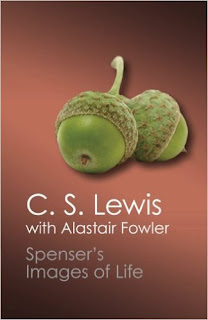Spenser's Images of Life
 Spenser's Images of Life, by C. S. Lewis and Alastair Fowler
Spenser's Images of Life, by C. S. Lewis and Alastair FowlerThis is my final preparation for the Faerie Queene Readalong next month! Once upon a time, C. S. Lewis left Magdalen College at Oxford and took a chair in Medieval and Renaissance Literature at Magdalene College at Cambridge, where he lectured in English literature for the last years of his life. (He commuted by train and went back to the Kilns on weekends.) Lewis had meant to make a book out of his Cambridge lectures on Spenser, but died before he could do so. His colleague Alastair Fowler took on the job of creating a book out of the lecture notes, and he succeeded well enough that Lewis' own voice still shows throughout. I first read this book several years ago, before Cambridge brought it back into print, and it made me want to read the Faerie Queene and enjoy it. I promptly failed, but this time I'm going to do it! (With the help of o and Cleo and a lot of footnotes.)
Lewis asserts that the Faerie Queene is very much like a pageant or masque: the kind of thing they used to put on at court, where you'd have a lot of fantastical figures dressed up, meant to present a scene to enjoy. You'd have gods and goddesses, or the Graces, or something like that, and they'd maybe perform a dance and the whole thing would be to compliment the king or queen. It's also very English; the opening scene (pictured on our readalong image) was apparently a standard one that people would immediately recognize and feel comfortable with, and Spenser is, throughout, a very English poet.
One pageant that Lewis describes particularly tickled me--it was put on at a tournament in 1511 and featured four knights: Ceure Loyall (Henry VIII), Joyous Panser, Bone Valoyr, and Valliaunt Desyre, all from the land of Noble Heart, on a sort of parade float with a mountain, trees, and deer. On the front, between two pillars, stood a maiden "in blue and light tawny satin making a garland of rosemary." The float was 'drawn' by a gold leopard and a silver antelope, which were led by two woodwoses! So that's the sort of thing we should be keeping in mind; that and the vast heritage of iconography that Spenser and his contemporaries were so familiar with, that we mostly are not.
Anyway, the point is that the Faerie Queene is meant to be highly visual and to present the readers with scenes to interpret and enjoy. And his thesis is life, love, righteousness, and plenty conquering death, sin, and decay. Over and over again, Spenser glorifies married love and virtue over vice and the old ideas about chivalric love and romance, which is always and by definition adulterous and, to Spenser, sterile. Each book presents us with a virtue to contemplate and scenes that should help us to understand that virtue leads to Life, while sin leads to Death. Spenser takes this so far as to use the married couple as an image of God: "it is the married couple, united in the relation called one flesh, that is the imago Dei."
Lewis takes us through several pieces of the Faerie Queene, pointing out how, in every book, there are images of Life, or good, or plenty, placed in opposition to scenes of fakery, stagnation, death, and sin. And we should always be careful to understand this poem for what it is--not an epic, or a novel--but:
...a pageant of the universe, or of Nature, as Spenser saw it. The vision is a religious but not a mystical one. For the poet's basic religion, the religion that underlies the forms of his imagination, is simply the worship of 'the glad Creator'....it is, as we say, a comment on life. But it is still more a celebration of life: of order, fertility, spontaneity, and jocundity. It is, if you like, Spenser's Hymn to Life.So let's hope I'm ready to tackle the real thing now! I've marshaled about as much help as it is possible to get.
 |
| My FQ pile! |





Thanks for sharing all this - I'm going to bookmark this post to refer back to! :) And I should really try and get a hold of this book!
ReplyDelete